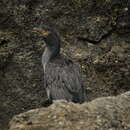Biology
provided by Arkive
A skilled hunter, the Pitt Island shag dives for fish and marine invertebrates, moving through the water with its large, webbed feet. After a fishing session it returns to land to dry out its wings, holding them out towards the sun. Unlike most waterbirds, the feathers are not waterproof; this is thought to be an adaptation to aid diving, as the shags are not kept buoyant by air bubbles amongst the feathers (2).
Shags breed in colonies on rocky shores once a year, the female laying chalky blue eggs in a loose nest while her partner stands guard or fishes. The young are fed by both parents, who regurgitate the contents of their stomachs on demand (2).
Conservation
provided by Arkive
The sheep and cattle of Rangatira were removed in 1961, as were the sheep of Mangere Island in 1968. This was judged to have had a beneficial effect and authorities are now working to remove feral cats and weka from Pitt Island, and sheep, cattle and pigs from parts of Pitt and Chatham Island that are deemed to be suitable for nesting colonies. Colonies that appear to be suffering as a result of stock may be fenced off in the future, depending on agreements with local people and landowners (2).
Description
provided by Arkive
The Pitt Island shag has two head crests, which distinguishes it from the cormorants, one on the forehead and the other on the crown. During the breeding season these are upright and resemble a Mohican, but during the winter season and in non-breeding birds they lie flat. Breeders have a black head, rump, tail and thighs and dark grey back and wings with small black spots. The underparts are lighter grey and the bare facial skin is green. Non-breeders have paler underparts and the facial skin fades temporarily to yellow. The female is silent, but the male is noisy, particularly when displaying (2).
Habitat
provided by Arkive
Shags are coastal rather than open-ocean waterbirds, choosing to return frequently to rocky shores, islets, and cliffs (2).
Range
provided by Arkive
Endemic to the Chatham Islands of New Zealand, the Pitt Island shag is found not only on the island of Pitt, but also on Chatham, Mangere, Little Mangere, Rangatira, Star Keys, the Pyramid, Big and Middle Sister, Murumurus, the Castle and Rabbit Islands (2).
Status
provided by Arkive
Classified as Endangered (EN) on the IUCN Red List 2007 (1).
Threats
provided by Arkive
The Pitt Island shag is severely restricted by limited breeding space. It is thought that breeding success is affected by the presence of several introduced species on the islands, including cattle, sheep, pigs, cats, dogs, rats and the weka bird (Gallirallus australis). Birds are sometimes illegally shot by fisherman for stealing their catch and they are also caught in very large numbers in crayfish pots. Changes in the marine environment associated with climate change may be affecting the prey species of the Pitt Island shag (2).
Pitt shag
provided by wikipedia EN
The Pitt shag (Phalacrocorax featherstoni), also known as the Pitt Island shag or Featherstone's shag, is a species of bird in the family Phalacrocoracidae. It is endemic to Pitt Island. Its natural habitats are open seas and rocky shores. It is threatened by habitat loss.
This representative of the shags in the Chatham Group was discovered by H.H. Travers in 1871. Buller dedicated the species to Dr Featherston, superintendent of the Province of Wellington at that time.
Apparently never a common species, it was reported as nearly extinct in 1905. The Department of Conservation does have a recovery plan for this bird.
Members of the shag family belong to three groups, based on the colour of their feet: black, yellow or pink. Outside New Zealand, the black-footed shags are better known as cormorants. The Pitt shag belongs to the yellow footed group.
References

- license
- cc-by-sa-3.0
- copyright
- Wikipedia authors and editors
Pitt shag: Brief Summary
provided by wikipedia EN
The Pitt shag (Phalacrocorax featherstoni), also known as the Pitt Island shag or Featherstone's shag, is a species of bird in the family Phalacrocoracidae. It is endemic to Pitt Island. Its natural habitats are open seas and rocky shores. It is threatened by habitat loss.
This representative of the shags in the Chatham Group was discovered by H.H. Travers in 1871. Buller dedicated the species to Dr Featherston, superintendent of the Province of Wellington at that time.
Apparently never a common species, it was reported as nearly extinct in 1905. The Department of Conservation does have a recovery plan for this bird.
Members of the shag family belong to three groups, based on the colour of their feet: black, yellow or pink. Outside New Zealand, the black-footed shags are better known as cormorants. The Pitt shag belongs to the yellow footed group.
- license
- cc-by-sa-3.0
- copyright
- Wikipedia authors and editors

